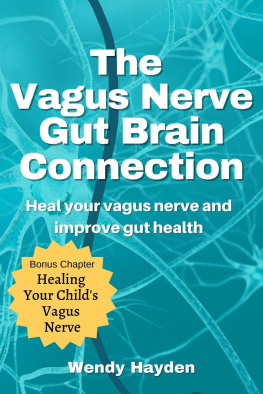THE VAGUS NERVE
Understanding its Physiology & Full Healing Potentials
Andrew Gray, MD
THE VAGUS NERVE
Copyright 2020
All rights reserved. No part of this publication may be reproduced or transmitted in any form or by any means, electronic or mechanical, including photocopy, recording, or any information retrieval system, without written permission from the publisher.
ISBN:
This edition of The Vagus Nerve by Andrew Gray, MD is published by an arrangement with Draft2Digital.
TABLE OF CONTENT
Introduction ..............................................................................
Introducing the nervous system ........................................
- Central nervous system
- Peripheral nervous system
Anatomy & Physiology of the 12 cranial nerves ..... 3
Physiological functions of the vagus nerve ...............
- Whats affected by the vagus nerve?
- The role of the vagus nerve in inflammation
- Vagal tone and its importance
- The brain-gut connection
- Vagus nerve and better mental health
Stress and the nervous system ...........................................
- The basics of stress
- What relationship does stress have with your nervous system?
- From chronic stress to inflammation: the pathway to ill health
Activating the healing powers of the vagus nerve?6
- The deep-breathing technique
- Loving-kindness meditation
- Yoga pose
- Massage
- Cold water splash
- Tai chi
- Sun exposure
- Fasting
References
T he vagus nerve is the longest nerve in the autonomic nervous system. It emanates from the brain. Information flowing through the vagus nerve goes to and from the brain surface to organs and tissues of the body. Vagus is derived from the latin word for wandering. It is so-named because the vagus nerve wanders from the brain to the organs in the abdomen, chest, and the neck.
Many people are yet to understand that the vagus nerve is probably the most important nerve in the human body. Compared to others, what happens in the vagus nerve doesnt stay there. It links the brainstem to the lungs, heart, and the gut. It innervates nearly most of the deep organs within us. It also innervates the liver, the gallbladder, the spleen, female reproductive organs, ureter, tongue, kidney, ears, and the neck.
Dysfunction of the vagus nerve can trigger a wide range of problems such as bradycardia, obesity, fainting, gastrointestinal disorders, mood disorders, etc.
On the other hand, stimulation of the vagus nerve improves the following conditions:
- Heart disease
- Anxiety disorder
- Tinnitus
- Migraines
- Leaky gut
- Obesity
- Mood disorders
- Poor blood circulation etc.
The Vagus Nerve explains in simple, and easy-to-understand words, the basic physiology of the vagus nerve and how to access its full healing potentials.
I understand that not everyone who purchases this book is medically-inclined, and so, it is written with no unnecessary medical jargons. It is brief, simple, and straight to the point.
In this book: The Vagus Nerve: Understanding its physiology & Full Healing Potentials, youll discover:
- The basics of the nervous system
- Anatomy & Physiology of the cranial nerves
- Physiological functions of the vagus nerve
- The role of the vagus nerve in inflammation
- The brain-gut connection
- Activating the healing powers of the vagus nerve
Your criticisms and reviews are welcome.
The Publisher
()
INTRODUCING THE NERVOUS SYSTEM
T he nervous system is one of the most incredible and complex systems in the human body. It is a control system, meaning that it is involved in the control of body functions. There are two major control systems in the body:
- The nervous system
- The endocrine system
The nervous system controls every activity in the human body. It performs its function quicker than the endocrine system. Basically, the nervous system comprises two sub-types:
- The central nervous system
- The peripheral nervous system
CENTRAL NERVOUS SYSTEM

T he central nervous system consists of the brain and the spinal cord. The brain is housed within the skull or the cranial cavity. The spinal cord on the other hand travels from the back of the brain, and through the center of the spine, terminating in the lumbar region of the lower back.
Both the brain and the spinal cord are located within the meninges. The meninges are a layer of protective membranes.
A lot of studies have been done on the central nervous system by both anatomists and physiologists, but then, theres still a lot to be learnt, and much more to be understood. The central nervous system holds many secrets; it controls our movements, thoughts, desires, and emotions. It takes charge of our heart rate, breathing, synthesis and release of some hormones, body temperature, etc.
The optic nerve, retina, olfactory epithelium, and olfactory nerves are in some cases, considered to be a part of the central nervous system alongside the spinal cord and the brain. Why is this so? Well, it is because they have a direct link with the brain tissue without the need for intermediate nerve fibers.
Let us study part of the central nervous system in detail.
The brain
The brain happens to be the most complex organ in the human body. The largest part of the brain (by volume) is the cerebral cortex. It contains about 15-33 billion neurons. Each neuron is connected to thousands of other neurons.
All in all, theres around 100 billion neurons and a thousand billion glial cells in the human brain. Glial cells are supporting cells. The human brain takes up no less than 20% of our bodys total energy.
The brain serves as the bodys central control module. It is responsible for the coordination of the bodys activities including physical motion, hormone secretion, memory consolidation, and the sensation of emotions.
To perform these functions at optimal capacity, some parts of the brain play very unique roles. However, it is worth noting that most higher functions, such as problem-solving, reasoning, creativity, etc. involve a lot of networking.
Your brain is split roughly into four lobes:
The temporal lobe: The temporal lobe is concerned with processing sensory input and assigning emotional interpretation. It is also involved in memory consolidation (laying down long-term memories). Language perception is also housed in the temporal lobe.
Next page














